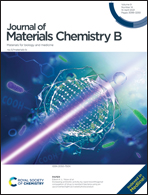Electrospun nanofibers promote wound healing: theories, techniques, and perspectives†
Abstract
At present, the clinical strategies for treating chronic wounds are limited, especially when it comes to pain relief and rapid wound healing. Therefore, there is an urgent need to develop alternative treatment methods. This paper provides a systematic review on recent researches on how electrospun nanofiber scaffolds promote wound healing and how the electrospinning technology has been used for fabricating multi-dimensional, multi-pore and multi-functional nanofiber scaffolds that have greatly promoted the development of wound healing dressings. First, we provide a review on the four stages of wound healing, which is followed by a discussion on the evolvement of the electrospinning technology, what is involved in electrospinning devices, and factors affecting the electrospinning process. Finally, we present the possible mechanisms of electrospun nanofibers to promote wound healing, the classification of electrospun polymers, cell infiltration favoring fiber scaffolds, antibacterial fiber scaffolds, and future multi-functional scaffolds. Although nanofiber scaffolds have made great progress as a type of multi-functional biomaterial, major challenges still remain for commercializing them in a way that fully meets the needs of patients.



 Please wait while we load your content...
Please wait while we load your content...